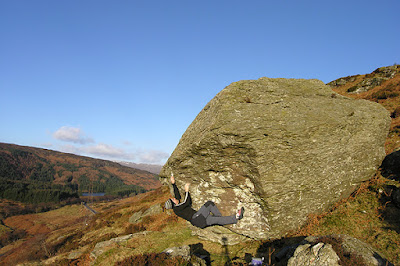The boulderer's idyll... seems like a while since we've had it...a sustained high pressure has dried out some of this extended autumn wetness (winter?) and I found myself on the flank of a glen, arm up against the sun ricocheting off a pylon, boulder mat throwing me a wobbler as I balanced over a barb-wire fence, following the sheep trails again... absorbed in that out-of-breathness as I toiled through steep heather to a spied shadow of steepness. Distant ribbons of vanishing snow on the Tarmachans like a sketched-out caricature of mountains, everything back in its place and the climbing simple and coming easily with renewed motivation, the body twisting eagerly and the hands hungry for the emery-rub of garneted rock. My eyes are always close to my hands when bouldering and I notice the little blood-nicks on my knuckles that the schist steals off me... you clock these little things and welcome them back...it's what makes bouldering special and personal, throwing shapes and finding the locks, chalking up holds and doing the dot-to-dot, like some over-cosseted and earnest kid pointing out all the capitals of the world on a map... we really do take it all too seriously sometimes, but bouldering is only properly done when it is child-like -no real thinking, just instinctive and impetuous movement and the delusion that the rock is taking you seriously... being spat off makes me laugh and I shake my head at my arrogance ... but what I pleasingly don't notice is the sun has passed over the hill and the shadows begin to swim up my legs like an ink-stain...
